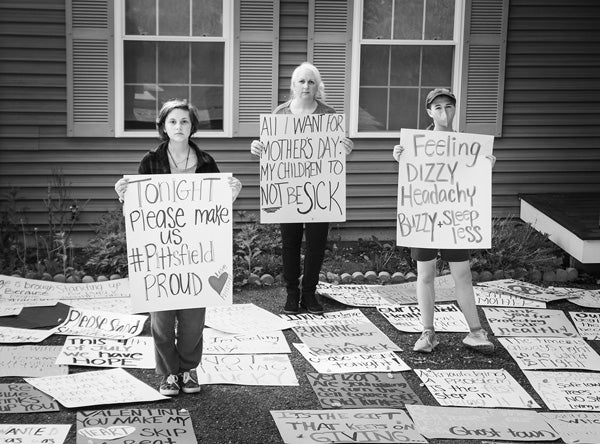
In 2020, when most of the world shut down in response to a declared viral pandemic, the lives of dozens of residents of a small town in Massachusetts were changed drastically, but from a completely different type of threat. Although schools and workplaces were shut down, one type of activity ramped up even more fervently: the clearing of forests, destruction and displacement of entire ecosystems of animals and insects, and the unchallenged construction of large, looming metal structures that characterizes the placement of new cell phone towers.
As almost all social activity in their lives had ceased, the residents of a neighborhood in Pittsfield, Massachusetts were bewildered and mortified as huge trucks (and trucks carrying other trucks) spent full days on the previously quiet, calm streets of their small town, building something unknown but clearly massive that nobody knew was coming. The many trucks coming and going daily changed the peaceful and quiet atmosphere to one of constant noise, air pollution from exhaust, and even damage to their roads and water lines from the heavy weight of the trucks, one time leaving them without water in their homes for a full day, with no way of leaving to seek out water elsewhere as the trucks blocked the roads.
In a place where kids used to play safely on the streets and neighbors would take their daily walks, the residents now found themselves cowering inside their homes, wondering what kind of behemoth was going to be their new neighbor.
When one resident questioned the construction company directly, they were told that a Verizon cell phone tower was being built.
Legally, a city that approves the construction of a new cell tower is required to send notice of the impending buildout to all residents within 300 feet of the construction zone. When questioned, the city of Pittsfield claimed they did just that, but did not have any proof, and none of the nearby residents had received any notice at all.
Upon further digging, they discovered that the tower was silently granted a permit in 2017, with only one resident in attendance. After being informed by residents of where the construction was occurring, City Councilor Christopher Connell told them the initial permit application raised no red flags to him, as the address that Verizon gave was deceptive – it implied that the tower would be placed at the other end of the 60-acre private lot, considerably further away from the residents’ homes than the space directly adjacent to the residential neighborhood where the tower was actually being built. Even more alarming, it was being built through an illegal access point to the property, located in the residential neighborhood.
“For this to appear at the other end, into a neighborhood, is deplorable in my opinion," Connell said.
As building continued, some of the residents took all the action they could think to take – taking photos of the construction, contacting the city and all local departments that could assist them in the matter, and even talking to the construction workers, who begin to verbally harass them. Even though the private lot the tower was being built on was technically zoned residential and had a height restriction of 35 feet, workers told residents that their area was okay to build on, as it was considered “open space” and “no one lived there”, and that the residents are considered “collateral damage” and “people of low education, living on land of low value.” They were told that the tower was going to get “up and on” before the residents had a chance to organize and try to fight back.
Later that year, there was a 115-foot cell phone tower right at the end of their street, all trees within the vicinity cleared to the ground, surrounded by a barbed wire fence.
At first, residents were most concerned about the ambiance of their neighborhood, the ugly view of the tower that replaced the beautiful forest outside their windows, and the inevitable plummeting of their property values as a result of the tower being placed so close to their homes. The local historical society was upset that the Herman Melville House Museum property was directly adjacent to the cell tower, marring the historical feel and appeal to tourists.
At that point, residents didn’t know they also needed to be worried about the health effects of the radiation... until the tower was turned on, and dozens of residents simultaneously began experiencing a kind of ill health they had never dealt with before.
17 residents fall ill after neighborhood cell tower is turned on
Soon after the tower was turned on, children and adults living nearby began experiencing symptoms of ill health they had never felt before. The day the tower was fired up, 13-year-old Amelia Gilardi’s little sister started feeling dizzy, headachy, and complaining of a buzzing in her head. Amelia didn’t even know what a cell tower was until construction began on their street, but soon her entire family was experiencing troubling symptoms they had not anticipated.
Neighbors began complaining of various health issues. Elaine Ireland, a local resident who had never been prone to headaches, began experiencing frequent headaches and ringing in the ears. Reports of dizziness, insomnia, heart palpitations, headaches, nausea and vomiting, skin rashes, and memory and cognitive issues began adding up. One person was so dizzy that he could no longer drive his car. Another got tinnitus so bad that he was considering moving. Some of the kids had to sleep with “vomit buckets” next to their beds. By the end of that year, the Gilardi family knew of at least 13 neighbors that were sick, and one had even developed cancer. After a couple years of continued exposure, there are now 17 neighbors complaining of issues, and 3 now have cancer.
Some of the residents were awakened to a sense of urgency that they needed to do whatever they could to either have the tower turned off, or moved further away – continuing to live in their homes, without their health being threatened, depended on it. Amelia’s mother, Courtney Gilardi, became one of the leading activists in this cause, repeatedly attempting to contact the local Health Department and calling attention to the issue at City Council meetings. At first, no one would listen, or do anything to help them.
The response from the city was not quick enough, and as the residents’ symptoms continued and even worsened, some had to sell their homes and move elsewhere, and others had to go stay with friends or even live in their cars. Amelia’s family had access to a small cottage a few miles away, where they retreated to find relief from their symptoms. The house was old, tiny, and infested with rats, with no personal space for the kids. Yet, the relief they felt from their radiation symptoms made it the only acceptable option. Over time, as their family dynamic became stressed and disrupted due to poor living conditions and their mother working full days just on the cell tower issue, the children yearned to be back in their home and living their normal lives.
One day, Amelia’s little sister told their mom that she doesn’t remember what it was like to live in their own house.
Amelia spoke in person at a local City Council meeting for the first time at age 13 – you can listen to her speech here. Since then, at only age 15, she has already spoken at more than 50 Board of Health and City Council meetings on this issue!
Pittsfield residents’ fight back finally gains traction
Finally, after much discussion, the City Council decided to send the issue to the Pittsfield Board of Health for an investigation. After combing through stacks of research papers and questioning a dozen scientists and doctors, which took a full 18 months, the members of the Board began waking up to the true potential for danger that wireless radiation has on human health. For the first time in United States history, a local Health Board issued an emergency cease-and-desist order, directing a cell phone company to shut down a cell tower. It was a bold move, but the stakes were high, and the residents were not backing down, as they were desperate for relief and resolution.
Unfortunately, the reaction was retaliatory – Verizon sued the City of Pittsfield, stating that their cell tower radiation was well within FCC exposure level guidelines, and essentially blaming the residents of faking their illnesses by stating that they must have psychological problems. Since the Pittsfield Board of Health had not allocated funds to support a lawsuit, they unfortunately chose to withdraw the order.
But Verizon and the other telecoms know just as well as the rest of us that the FCC guidelines were set way back in 1996, based on the comparatively meager radiation levels most of humanity was exposed to at the time from the sporadic fancy flip phone, pagers and cordless home phones. Furthermore, the guidelines are based only on exposure levels that produce thermal (heating) effects, while thousands of studies have proven there are non-thermal harmful effects of RF radiation. Of course, they are dead set on never admitting publicly that they know all this, as it would cut a huge chunk from their profits.
For a detailed explanation of why the FCC guidelines are outdated and allow nearly every life form to be exposed to dangerous levels of radiation with no recourse, you can read our article on the current court order requiring the FCC to address the mountain of evidence on health harms and update their 1996 safety guidelines accordingly:
FCC Under Fire: The Pressure Is On For Radiofrequency Safety Guideline Updates
At this point, they are just delaying the inevitable. Sooner or later, justice will find them, and they will have to backtrack so far that the industry itself may face a kind of collapse! But how long is it going to take for the final blow to be dealt, illegal and harmful cell towers shut down (or at least moved further away from people), so that people like Amelia Gilardi’s family, Elaine Ireland, and over a dozen of their neighbors can move back into the homes they own, and resume their normal lives?
Children’s Health Defense steps in to help
Since the city withdrew the cease-and-desist order, and the story has gained traction in the media, Children’s Health Defense stepped in and picked up the case. CHD is determined to help these people get back in their homes safely, and to fight to set a new precedent to win future cases where the telecoms are unjustly driving people out of their homes.
The attorney on the case is Scott McCullough, CHD’s leading litigator for electromagnetic radiation cases, and the very same attorney who recently fought (and won!) to require the FCC to update their outdated safety guidelines!
This legal battle is still ongoing. In June, a superior court judge ruled that the lawsuit can move forward, after some objections from Verizon tried to put a halt to the case. The court is admitting that the plaintiffs (the local residents and CHD) have a valid case to be made, and they want to hear more.
The revolutionary and incredibly important work that Children’s Health Defense attorneys are doing to protect children (and all living beings) from harmful environmental factors including wireless radiation requires continuous funding, as they are a non-profit organization.
Our Blushield USA team is made up of a few families, and most of us have children of our own. We strongly believe in the importance of the work CHD is doing, which is why we support them with monthly financial contributions! When you purchase your Blushield home and portable EMF protection devices, know that you are helping us to financially support the vitally important cases that Children’s Health Defense takes on.
You can read more about Our Causes here
References:
- Children’s Health Defense: “15-year-old Activist Stands Up to Big Telecom” – https://live.childrenshealthdefense.org/chd-tv/shows/good-morning-chd/15yearold-activist-stands-up-to-big-telecom/
- Safe Tech International: “5G Earth Day Countdown: Children – Amelia’s Terrible, Horrible, No Good, Very Bad Cell Tower Days” – https://safetechinternational.org/5g-earth-day-countdown-children-amelias-terrible-horrible-no-good-very-bad-cell-tower-days/
- Children’s Health Defense: “Lawsuit Over Verizon Cell Tower Can Proceed, Judge Rules” – https://childrenshealthdefense.org/defender/pittsfield-verizon-cell-tower-lawsuit-proceeds/
- Environmental Health Trust: “Pittsfield, MA Board of Health Unanimously Votes to Issue Cease and Desist for Verizon Cell Tower” – https://ehtrust.org/pittsfield-ma-board-of-health-unanimously-votes-to-issue-cease-and-desist-for-verizon-cell-tower/

